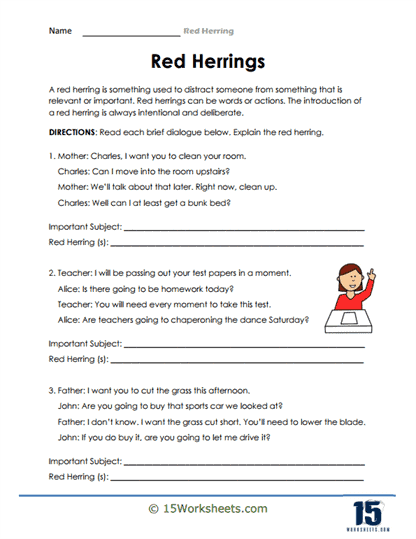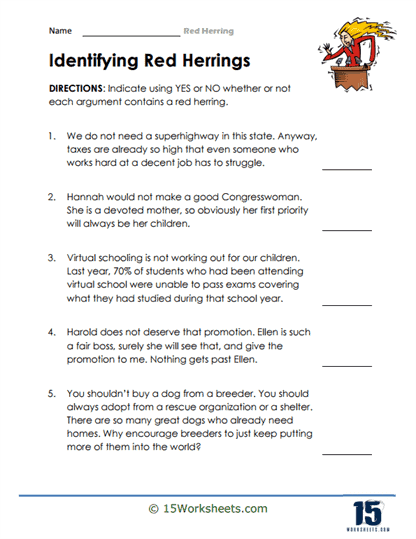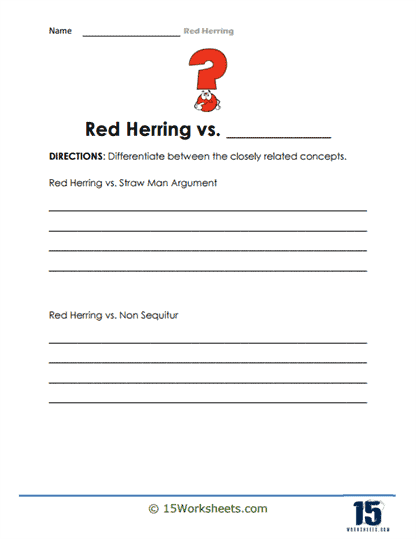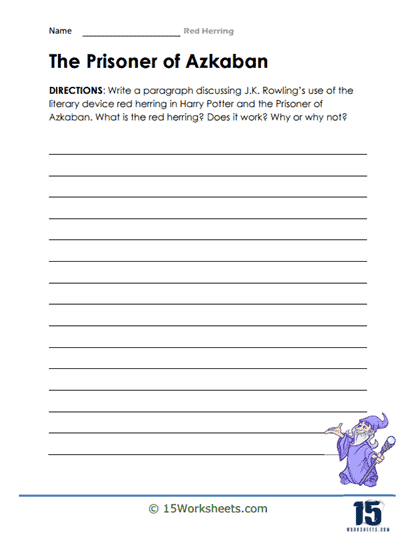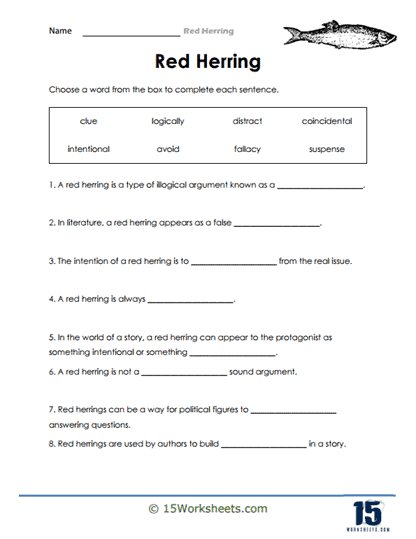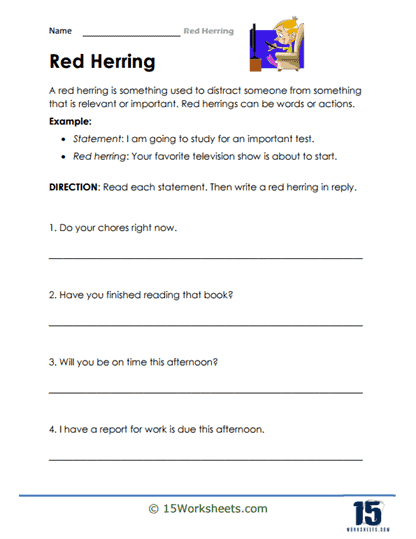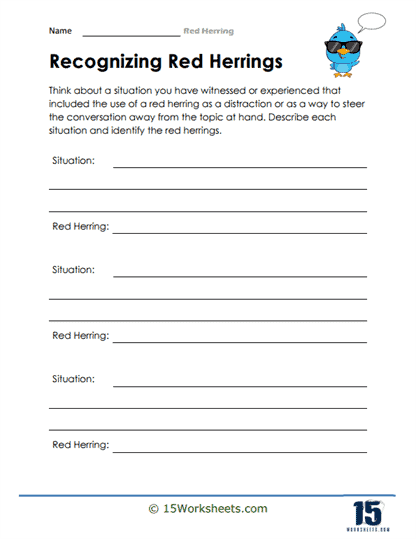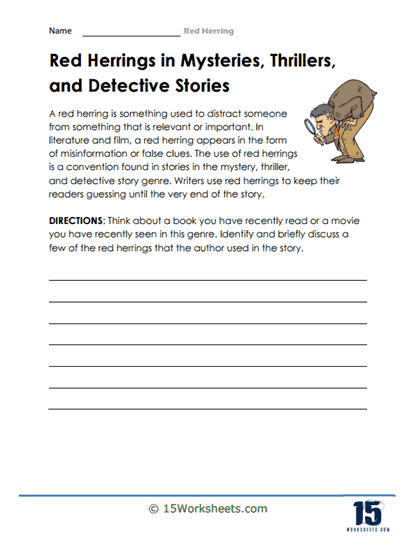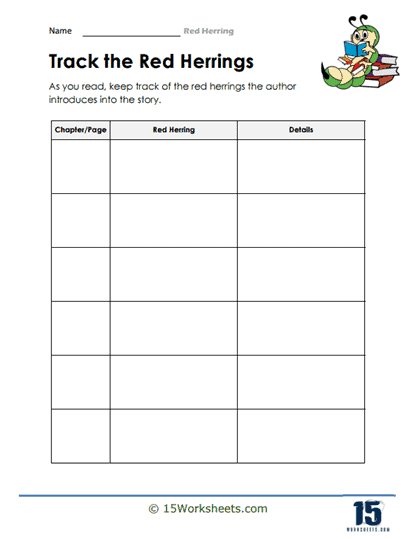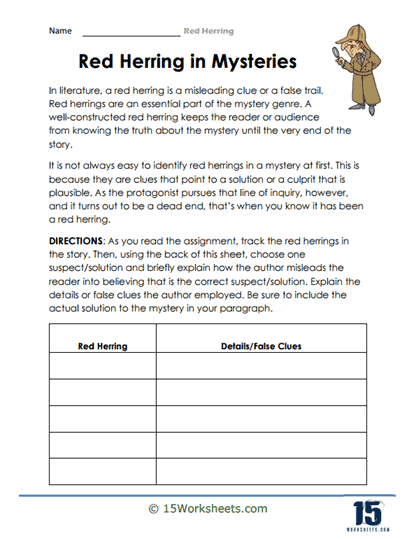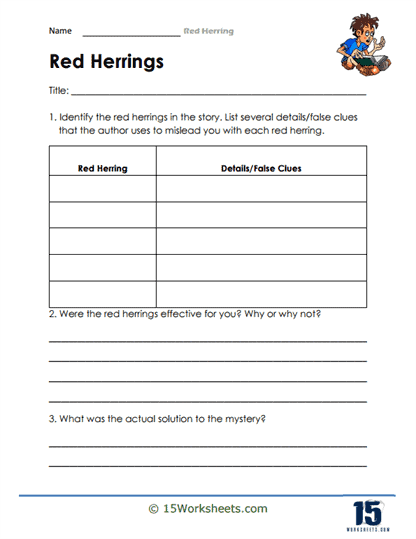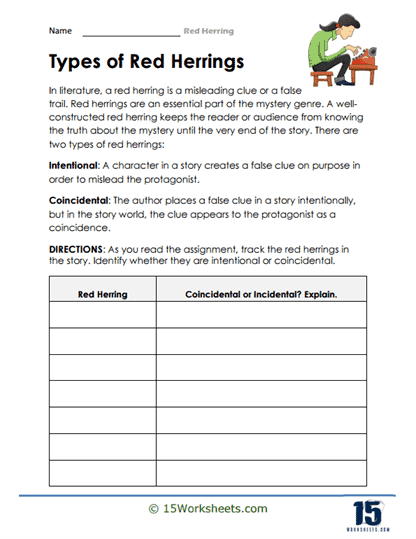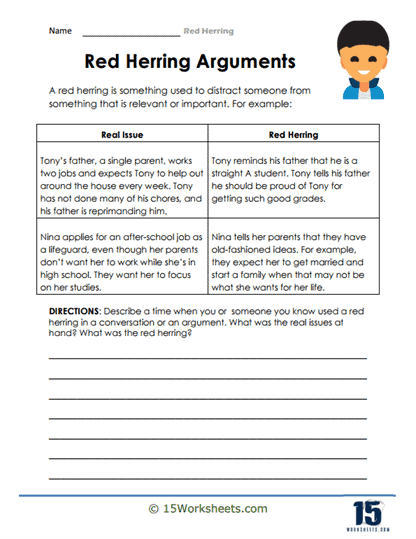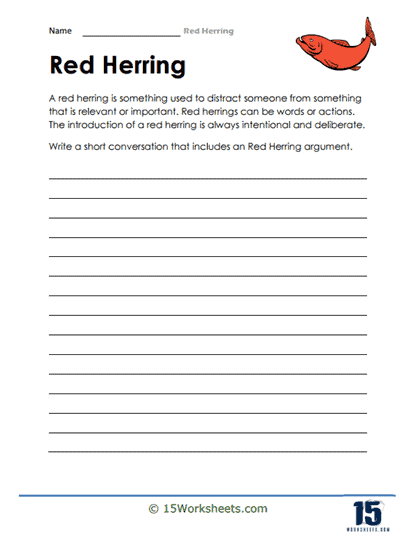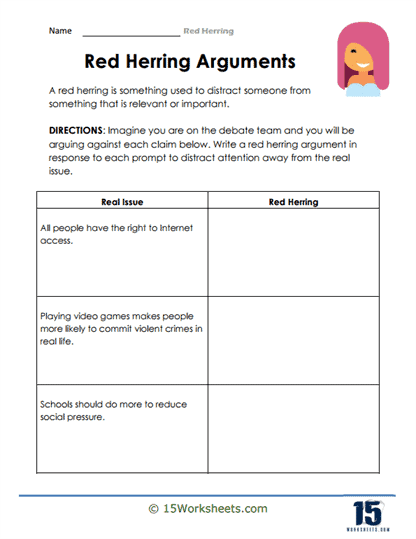Red Herring Worksheets
All About These 15 Worksheets
A red herring, a misleading clue or distraction that diverts attention from the real issue or solution, is a critical concept for students to grasp, as it equips them with the skills to identify and navigate deception, both in literature and in real-life scenarios.
Understanding red herrings is essential not only for enhancing critical thinking but also for honing analytical skills, problem-solving abilities, and the capacity to make informed decisions. This collection of 15 worksheets is designed to introduce students to the world of red herrings, helping them recognize the importance of this concept, identify its various forms, and develop their own critical thinking and problem-solving skills.
What Are Red Herring Worksheets?
These worksheets can help students learn about the literary device known as a “Red Herring”. This might sound a little strange at first, because a “red herring” is a type of fish. But in literature, a red herring is a clue or piece of information which is intended to be misleading, or distract the reader from the important details or the truth.
Imagine you’re reading a mystery story where you’re trying to figure out who stole the cookies from the cookie jar. A red herring might be a clue that makes you think your sister did it, when actually, it was your brother all along. The false clue about your sister was a “red herring” to lead you astray.
Our Red Herring worksheets contain different types of exercises to help you understand and identify this concept better.
Identification – The worksheet might contain a short story or an excerpt from a novel with a few red herrings. The exercise would involve identifying these misleading clues.
Creation – A fun exercise might ask you to write your own short mystery story, using a red herring to mislead the reader.
Discussion Questions – You might find questions that make you think more about why authors use red herrings, and how they affect the story.
Remember, the purpose of these worksheets is to help you understand what a red herring is, why authors use them, and how to spot them in a story. This can make reading even more fun, especially when you’re able to guess the red herrings and solve the mystery before the characters in the story do!
Why Do Authors Use Red Herring As a Literary Device?
A Red Herring is a narrative element often used in literature, films, and TV shows, primarily in mystery and crime genres, but not exclusively. The primary function of a Red Herring is to mislead or distract the reader or viewer from the pertinent details, providing a surprise when the truth is eventually revealed. It is a tactic that diverts the attention of an audience from the key issue or object and sidetracks them on an unrelated or less relevant issue. The concept of the Red Herring can be dated back to the tradition of using a cured and smoked fish, a herring, to distract hunting dogs from the scent of their prey.
The main defining feature of a Red Herring is its function as a deliberate deception. By making the audience focus on false clues or information, it heightens suspense, enhances narrative complexity, and often results in a surprising twist in the plot.
Examples of Red Herrings Used in Literature
“Harry Potter and the Philosopher’s Stone” by J.K. Rowling
Throughout the novel, Rowling expertly uses the Red Herring device. The character of Professor Snape is portrayed as a villainous figure, making both Harry and the reader suspicious of his actions. Snape’s interactions with Harry and his knowledge of the Dark Arts make him the perfect candidate as the person trying to steal the Philosopher’s Stone. In reality, the timid Professor Quirrell is the true villain, a surprise only revealed at the climax. The misleading clues pointing towards Snape were all Red Herrings to divert attention from the true villain.
“And Then There Were None” by Agatha Christie
This classic mystery novel is filled with Red Herrings. Ten people are invited to an isolated island, and one by one, they’re killed off. Throughout the novel, Christie cleverly leads readers to suspect different characters. However, each suspected character ends up being the next victim, hence serving as a Red Herring. The true killer, U.N. Owen (unknown), is revealed only in the postscript, a surprise to both the remaining characters and readers.
“To Kill a Mockingbird” by Harper Lee
Boo Radley is used as a Red Herring throughout this famous novel. His reclusive nature and the rumors surrounding him create an aura of mystery and fear. Scout and Jem, along with their friend Dill, spend the majority of their summer trying to lure Boo out of his house because they’re led to believe he’s a kind of monster. However, he turns out to be a misunderstood, kind figure who ultimately saves Scout and Jem from the real danger, Bob Ewell. The negative image of Boo Radley acts as a Red Herring, drawing our attention away from the more harmful characters in the town of Maycomb.
Using Red Herrings, authors can skillfully control narrative tension, lead their readers on a merry chase, and ensure a dramatic surprise or reveal. While this technique is most commonly associated with mystery and crime genres, it can be used in any story that benefits from misdirection and surprise. Understanding Red Herrings not only enhances our reading comprehension but also heightens our enjoyment as we try to outsmart the author and solve the mystery before the truth is revealed.
Benefits Of Red Herring Worksheets For Students
Exploring the world of red herrings through this collection of 15 critical thinking worksheets offers students an opportunity to develop essential skills in critical thinking, analytical reasoning, problem solving, media literacy, and decision making. Red herrings are deceptive tactics that challenge students to question information, recognize diversionary tactics, and focus on what truly matters.
By engaging with these exercises and activities, students not only enhance their academic abilities but also gain valuable tools for navigating the complexities of information, misinformation, and deception in today’s world. The benefits of studying red herrings extend far beyond the classroom, empowering students to be more discerning, critical, and informed individuals who can effectively separate fact from fiction in an increasingly information-rich society.

